 Last additions - Koka 甲賀市 Last additions - Koka 甲賀市 |
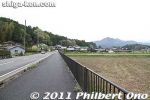
Aburahi Shrine is a 30-min. walk from Aburahi Station. I could've rented a bicycle, but walking was going to be more convenient for me.Jun 26, 2011
|
|
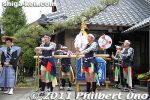
Jun 26, 2011
|
|
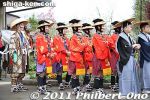
From Aburahi Shrine, the procession takes a circular 9-km route to as far as Koka Station (around 3 pm), then they return via Aburahi Station and Shirahige Shrine before reaching Aburahi Shrine at 6 pm.Jun 26, 2011
|
|
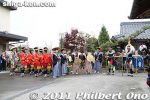
The festival is a procession combined with Shinto ceremonies. The procession was to arrive at Aburahi Shrine at 10:30 am. Before proceeding to the shrine, the group had a pep talk in their neighborhood.Jun 26, 2011
|
|
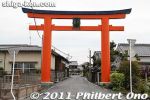
Aburahi Shrine worships Sarutahiko, a god of strength also revered by the samurai. A large torii over the road near the Aburahi Station.Jun 26, 2011
|
|
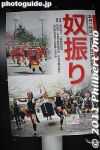
Poster for Aburahi Matsuri in 2011. The Aburahi Matsuri festival ceremony is held every year on May 1, but the colorful yakko-furi procession of over 100 people is held only once every 5 years. Jun 26, 2011
|
|
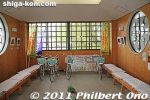
Rental bicycles at Aburahi Station's waiting room. The round windows have a ninja shuriken throwing knife design.Jun 26, 2011
|
|

Inside Aburahi Station.Jun 26, 2011
|
|
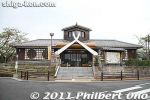
Held only once every five years, the Aburahi Festival with the yakko-furi procession was held by Aburahi Shrine in Koka, Shiga Prefecture, Japan on May 1, 2011.The procession features yakko samurai laborers who carry a trunk and sing. Others also dance. The procession makes a circular route near Aburahi and Koka Stations on the JR Kusatsu Line. Aburahi Station on the JR Kusatsu Line. Very nice design.Jun 26, 2011
|
|

Hiroshige's woodblock print of Minakuchi (51st post town on the Tokaido) from his "Fifty-Three Stations of the Tokaido Road" series. A summer scene of a few women drying gourd shavings to make kanpyo.Apr 24, 2011
|
|

Ukiyoe print of Tsuchiyama-juku by Hiroshige. People at the head of a daimyo procession are crossing a bridge over a river near Tamura Shrine during spring rains. Now see the bonkei in the next photo.Apr 24, 2011
|
|

Apr 24, 2011
|
|

My YouTube video of the Kenketo Odori Festival.Jun 06, 2010
|
|

Kenketo Odori poster. The word "kenketo" is written in katakana, but the kanji is written as 献鶏頭 which is not accurate in meaning. It was just made up. No one is sure what kenketo means in Japanese.May 31, 2010
|
|

Then they took a break and most people left. After the break at 4 pm, they danced again at the baba and went to the Otabisho near Yasu River where a ceremony was held. The portable shrines are also carried around. May 31, 2010
|
|

They dance again in front of the shrine office. 社務所前で宮踊りMay 31, 2010
|
|

Festival waste material.May 31, 2010
|
|

Festival spectatorsMay 31, 2010
|
|

May 31, 2010
|
|

May 31, 2010
|
|

Due to the tall peacock feathers, the boys have to put their head down when going through the gate.May 31, 2010
|
|
|

May 31, 2010
|
|

May 31, 2010
|
|

May 31, 2010
|
|

May 31, 2010
|
|

May 31, 2010
|
|

May 31, 2010
|
|

May 31, 2010
|
|
|

May 31, 2010
|
|

May 31, 2010
|
|

May 31, 2010
|
|

They danced in front of Tenmangu Shrine, then danced around the shrine a few times.May 31, 2010
|
|

The boys are taken to Tenmangu Shrine.May 31, 2010
|
|

May 31, 2010
|
|

The boys were then taken to the other shrine.May 31, 2010
|
|

May 31, 2010
|
|

May 31, 2010
|
|

May 31, 2010
|
|

May 31, 2010
|
|

May 31, 2010
|
|

Kenketo dancers dancing around Tagi Daimyojin-no-Miya Shrine.May 31, 2010
|
|

First, in front of Tagi Daimyojin-no-Miya Shrine, they danced and then danced around the shrine building a few times.May 31, 2010
|
|

May 31, 2010
|
|

The boys were then taken to the shrine.May 31, 2010
|
|

Kenketo dancer and his reward.May 31, 2010
|
|

May 31, 2010
|
|

May 31, 2010
|
|
|

May 31, 2010
|
|

May 31, 2010
|
|

May 31, 2010
|
|

May 31, 2010
|
|

May 31, 2010
|
|

It's a real frenzy. I managed to pick up a plastic flower.May 31, 2010
|
|

This flower umbrella came all the way to where I was.May 31, 2010
|
|

May 31, 2010
|
|

These kenketo dancers got a lot of goodies. They deserve it since they practiced hard for the dance.May 31, 2010
|
|

Once in a while, a flower umbrella was dedicated only to the kenketo dancers so it went directly to them. There are 20 flower sticks on these flower umbrellas.May 31, 2010
|
|

May 31, 2010
|
|

May 31, 2010
|
|

May 31, 2010
|
|

May 31, 2010
|
|

They knock down the flower umbrella and people rush in to grab something. They repeated this several times. This part of the festival is called Hanabai (花ばい).May 31, 2010
|
|

May 31, 2010
|
|

The next part of the festival featured numerous hanagasa flower umbrellas stuffed with little goodies.May 31, 2010
|
|

The fun part of the festival was when the hanagasa is offered to the crowd who fight over the spoils of the flower umbrella.May 31, 2010
|
|

The first hanagasa went directly to the kenketo dancers. They pulled out the little sticks attached with things like towels, gloves, and maybe some cash.May 31, 2010
|
|

May 31, 2010
|
|

Kenketo dancer, ShigaMay 31, 2010
|
|

Kenketo dancers wearing peacock, pheasant and other bird feathers. Their feathered cap is called shagama. シャガマMay 31, 2010
|
|

Up they go on human shoulders.May 31, 2010
|
|

The kenketo dancers are put on men's shoulders whenever they are not dancing.May 31, 2010
|
|

Besides the two baton twirlers at the front, there are these boys who play the drums and bell. They just danced across the baba once and stopped.May 31, 2010
|
|

Kenketo Odori dance at Tagi Shrine, Tsuchiyama, Shiga.May 31, 2010
|
|

They perform the baba odori kenketo dance at the baba area.May 31, 2010
|
|

Shrine parishioners from three districts (Maeno, Iwamuro, and Tokuhara (前野、徳原と甲賀町岩室) around the shrine participate in the Kenketo Matsuri. Each district takes turns providing the boys who dance each year. May 31, 2010
|
|

They dance to live music with drums, bell, and flute. The Kenketo Odori dance of Tagi Shrine is a National Intangible Folk Cultural Property. 国選択無形民俗文化財May 31, 2010
|
|

Kenketo Odori Dance at Tagi Jinja Shrine in Tsuchiyama, Shiga Prefecture.May 31, 2010
|
|

Kenketo Odori is a dance performed by eight boys aged 7 to 12. The dance was originally started to ward off calamities. The boys wear tall peacock feathers on their heads. May 31, 2010
|
|

After the festival umbrellas, the young boys started their kenketo odori dance on the baba area. 馬場踊りMay 31, 2010
|
|

Behind the shrine priest are three festival umbrellas. 三基の傘鉾(日、月、矢)May 31, 2010
|
|

May 31, 2010
|
|

After going up the steps, the procession reached the shrine at about 1:45 pm.May 31, 2010
|
|

Kenketo procession passing by tea field.May 31, 2010
|
|

At the Otabisho in Maeno at around 1 pm, they hold a ceremony. Then the Kenketo procession, led by the shrine priest, head for Tagi Shrine. May 31, 2010
|
|

May 31, 2010
|
|

Kenketo dancers, wearing peacock feathers, are carried on shoulders.May 31, 2010
|
|

The main halls of both shrines: Tagi Daimyojin-no-Miya on the right and Tenmangu on the left. In 2005, both these shrine buildings were rebuilt anew. They look very new and nice.May 31, 2010
|
|

Tagi Daimyojin-no-Miya Shrine is dedicated to the water god, for protection against floods. Long ago, nearby rivers often flooded this area. 龍樹大明神宮May 31, 2010
|
|

The other shrine is Tenmangu dedicated to Sugawara Michizane, god of scholarly learning. Popular with students. 天満宮May 31, 2010
|
|

Tenmangu Shrine in Tsuchiyama, Shiga. 天満宮May 31, 2010
|
|

Tagi Jinja actually consists of two shrines. One is this Tagi Daimyojin-no-Miya Shrine mainly dedicated to a god called Haya-akitsu-Hiko-no-Mikoto (速秋津比古之命) and Haya-akitsu-Hime-no-Mikoto (速秋津比 之命). 龍樹大明神宮May 31, 2010
|
|

Bull statueMay 31, 2010
|
|

Honden Halls beyond the fence.May 31, 2010
|
|

Haiden Hall on the right and children's mikoshi on the left.May 31, 2010
|
|

Haiden Hall was rebuilt anew in 2005.May 31, 2010
|
|

This is the area (called baba 馬場) where the Kenketo Odori will be performed. The boys will proceed up this path toward the shrine, while a crowd will watch on both sides.May 31, 2010
|
|

Tagi Shrine's closest bus stop is Higashi Maeno. Buses run from Kibukawa Station.May 31, 2010
|
|

Another path to Tagi Jinja Shrine in Tsuchiyama, Shiga.May 31, 2010
|
|

Tagi Shrine is amid tea fields. Tsuchiyama is a major tea-producing area.May 31, 2010
|
|

Behind the shrine is Yasu River which apparently often flooded the area in the old days. 野洲川May 31, 2010
|
|

Yasu River.May 31, 2010
|
|
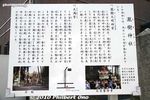
About Tagi Shrine. The shrine was established to protect the area from flooding by two nearby rivers. Thus it is near the river.May 31, 2010
|
|

Steps going up to the shrine. The Kenketo procession will go up these steps to enter the shrine.May 31, 2010
|
|

Large sacred tree.May 31, 2010
|
|

Torii to Tagi Jinja.May 31, 2010
|
|

Path to the shrine. The shrine is in Maeno in Tsuchiyama. MAPThis Kenketo Odori Dance has been inscribed as a UNESCO Intangible Cultural Heritage in 2022 as one of Japan's furyu-odori (風流踊) ritual dances.May 31, 2010
|
|

Held on May 3 by Tagi Jinja Shrine (龍樹神社) in Tsuchiyama, the Kenketo Matsuri Festival is highlighted by the Kenketo Odori Dance. The road to the shrine is marked with festival banners.May 31, 2010
|
|

This is an autograph by Shiga Governor Kada Yukiko who visited the Ninja House on April 24, 2009. In red reads "Mottainai," her motto meaning "Wasteful," in reference to spending of tax dollars.Mar 27, 2010
|
|

Miho Museum has several exhibition rooms featuring art from various parts of the world. It also has a restaurant and coffee shop.Sep 30, 2009
|
|

Sep 30, 2009
|
|

Entrance to Miho Museum which has an excellent collection of art from most parts of the world. Photography is not allowed inside the museum. MAPSep 30, 2009
|
|

Also in Shigaraki is Miho Museum, designed by I.M. Pei, in the middle of the mountains. From Shigaraki Station, it's a 25-min. bus ride. (Or 50 min. by Teisan Bus from JR Ishiyama Station in Otsu.) This nice tunnel leads to the museum.Sep 30, 2009
|
|

Minakuchi's hikiyama have four wheels and two levels. The wooden construction is complex and the carvings are exquisite.Jul 04, 2009
|
|

Each of the hikiyama floats are named after their respective neighborhoods.Jul 04, 2009
|
|

Food and game stalls crowd an adjacent area.Jul 04, 2009
|
|

Readying the paper lanterns to be decorated on the float for the festival eve later in the evening on April 19.Jul 04, 2009
|
|

The hikiyama floats are about 5 to 6 meters high and 3 to 4 meters wide.Jul 04, 2009
|
|

Jul 04, 2009
|
|

On April 19, ornate floats called hikiyama are taken out of their storehouses and prepared for the festival. Jul 04, 2009
|
|

Jul 04, 2009
|
|

Hikiyama floats started to appear at Minakuchi Hikiyama Matsuri in 1735. Initially, there were nine floats. This number increased to as many as 30 hikiyama floats.Jul 04, 2009
|
|

The hikiyama storehouses line the main streets of Minakuchi. There are 16 hikiyama floats. However, only 6 or 7 of them are paraded on the streets during the festival.Jul 04, 2009
|
|

Unlike the floats used in Kyoto's famous Gion Matsuri, Minakuchi's hikiyama floats are not disassembled. They are stored in their constructed state. Koka, Shiga.Jul 04, 2009
|
|

Minakuchi Hikiyama Matsuri posterJul 04, 2009
|
|

Jul 04, 2009
|
|

A mikoshi stands by to be carried during the festival.Jul 04, 2009
|
|

Minakuchi Jinja Shrine, which holds the annual Minakuchi Hikiyama Matsuri on April 19-20, is decorated for the festival. Map: https://goo.gl/maps/yZ2c6hMoGQJ2Jul 04, 2009
|
|

Minakuchi Shrine is dedicated to a god named Ominakuchi-sukune-no-Mikoto, the founder of Minakuchi.Jul 04, 2009
|
|

Old Tokaido RoadJul 04, 2009
|
|

Basho Matsuo Haiku monument at Daikoji temple.Jul 04, 2009
|
|

Minakuchi Shrine torii 水口神社Jul 04, 2009
|
|

Rock with Buddha's footprints.Jul 04, 2009
|
|

Minakuchi Jonan Station on the Omi Railway Line. The library, museum, Minakuchi Castle, and Minakuchi Shrine are near this station.Jul 04, 2009
|
|

Minakuchi Castle Museum is open 10 am to 4 pm, closed on Thursday and Fri. 水口城資料館Jul 04, 2009
|
|

The only part of the castle that looks like a castle is the small, rectangular area (connected by a short bridge) seen on the left side of the map. The large square area on the right is now an athletic/sports ground as you can see in the next picture.Jul 04, 2009
|
|

Minakuchi Christian Church designed by Vories. 水口教会会堂Jul 04, 2009
|
|

An early map of Minakuchi-juku.Jul 04, 2009
|
|

Another intersection.Jul 04, 2009
|
|

Another clock monumentJul 04, 2009
|
|

Near the forked intersection is Daitokuji Temple. Originally a Zen temple, it now belongs to the Jodo-shu sect. When Tokugawa Ieyasu passed through and visited the temple, he renamed it Daitokuji. 大徳寺Jul 04, 2009
|
|

Jul 04, 2009
|
|

About Minakuchi StoneJul 04, 2009
|
|

The castle later became the residence of the Minakuchi clan in 1682 headed by Lord Kato Akitomo. MAPJul 04, 2009
|
|

Local shrine 五十鈴神社Jul 04, 2009
|
|

Nearing the end of Minakuchi-juku.Jul 04, 2009
|
|

Pilgrimage clothingJul 04, 2009
|
|

A famous tree at Daitokuji.Jul 04, 2009
|
|

At the east end of Minakuchi-juku is the spot where the Kosatsu bulletin board stood. Jul 04, 2009
|
|

Stone monument commemorating the formation of Koka upon the merger of neighboring towns. (Minakuchi, Koka, Shigaraki, Konan, Tsuchiyama)Jul 04, 2009
|
|

Jul 04, 2009
|
|

Jul 04, 2009
|
|

The Honjin was the town's most exclusive lodge reserved for daimyo lords, government officials, and even Emperor Meiji who once stayed here as this monument indicates.Jul 04, 2009
|
|

Pieces from Minakuchi Okayama Castle ruins.Jul 04, 2009
|
|

The Honmaru (main keep) is now the sports ground for Minakuchi High School.Jul 04, 2009
|
|

This is a reconstruction of the Kosatsu bulletin board which displayed official notices from the shogunate. These bulletin boards were placed where many people passed by so they can stop and read the bulletins. 高札場Jul 04, 2009
|
|

Jul 04, 2009
|
|

PipesJul 04, 2009
|
|
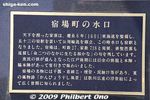
In 1601, Minakuchi-juku was designated as the 50th stage or post town on the Tokaido Road. It had 718 households. By the late Edo Period, Minakuchi had over 40 inns as well as a Honjin. Today, Minakuchi is one of the main populated areas of Koka.Jul 04, 2009
|
|

Hikiyama Festival Plaza in front of Minakuchi Jonan Station.Jul 04, 2009
|
|

Pipe engraved with "Minakuchi."Jul 04, 2009
|
|

Near Minakuchi Shrine are these storehouses for hikiyama floats.Jul 04, 2009
|
|

Walk a little further east and north to visit the former Minakuchi Public Library designed by William Vories and built in 1928.Jul 04, 2009
|
|

Minakuchi ShrineJul 04, 2009
|
|

Pond for the souls of fish offered to the temple.Jul 04, 2009
|
|

Jizo statues next to the Daitokuji Temple Hondo Hall. Jul 04, 2009
|
|

Jul 04, 2009
|
|

Minakuchi ShrineJul 04, 2009
|
|

About Vories.Jul 04, 2009
|
|

Jul 04, 2009
|
|

Jul 04, 2009
|
|

Sample bulletins on the Kosatsu bulletin board. That's a lotta fine print...Jul 04, 2009
|
|

Minakuchi Hikiyama float storehouseJul 04, 2009
|
|

Old Tokaido Road in MinakuchiJul 04, 2009
|
|

Kibukawa Station, terminus of the Omi Railway Line and connection to the JR Kusatsu Line.Jul 04, 2009
|
|

After reaching Higashi-Mitsuke Gate, backtrack back to the train station and cross the train tracks to the other side of the Tokaido Road. You will be heading toward Minakuchi Castle. Minakuchi manhole. Shiga Pref.Jul 04, 2009
|
|

Monument for Iwaya Ichiroku, a noted calligrapher hailing from Minakuchi.Jul 04, 2009
|
|

Not far from the Kosatsu bulletin board was Minakuchi-juku's Honjin. Nothing remains of the Honjin. This is the entrance to where it was located. 本陣跡Jul 04, 2009
|
|

Woodblock prints which depict Minakuchi.Jul 04, 2009
|
|

Saw this along the way to Minakuchi Castle.Jul 04, 2009
|
|

Jul 04, 2009
|
|

Inside Minakuchi Castle Museum 水口城資料館Jul 04, 2009
|
|

Daikoji temple's bell tower. 「木造千手観音立像」と「木造阿弥陀如来立像」は寺の関係者が勝手に持ち出したあと第三者に売り渡された。Jul 04, 2009
|
|

Now we are approaching Minakuchi Shrine.Jul 04, 2009
|
|

A detour on the old Tokaido road, created due to the castle grounds.Jul 04, 2009
|
|

According to NHK in Oct. 2013, the whereabouts of two Important Cultural Property Buddhist statues from Daikoji temple in Koka are unknown. Reported to be have been stolen & sold.Jul 04, 2009
|
|

Reconstructed Higashi-Mitsuke Gate. 東見附跡Jul 04, 2009
|
|
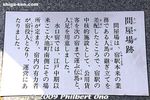
About Minakuchi-juku's Toiyaba.Jul 04, 2009
|
|

Jul 04, 2009
|
|

Jul 04, 2009
|
|

Minakuchi ShrineJul 04, 2009
|
|

Way to Shintokuji temple. 真徳寺Jul 04, 2009
|
|

Shintokuji temple. 真徳寺Jul 04, 2009
|
|

A tree shows where the Ichirizuka marker was. It served as a milestone and distance marker for travelers.Jul 04, 2009
|
|

Daikoji temple was founded in 684 by priest Gyoki (行基) who installed a wooden Thousand-Arm Kannon statue (now missing). 大岡寺Jul 04, 2009
|
|

Jul 04, 2009
|
|

A short walk from Minakuchi Ishibashi Station is Minakuchi Chubu Community Center.Jul 04, 2009
|
|

Entrance to the former Minakuchi Public Library has Romanesque columns.Jul 04, 2009
|
|

Jul 04, 2009
|
|

Former Minakuchi Public Library is next to Minakuchi Elementary School. 旧水口図書館Jul 04, 2009
|
|

Staircase inside former Minakuchi Public Library.Jul 04, 2009
|
|

1: Honjin, 2: Waki-Honjin, 3: Kosatsu bulletib board. Daikoji temple can also be seen on the upper left.Jul 04, 2009
|
|

A more traditional-looking part of the former Tokaido Road.Jul 04, 2009
|
|

Daitokuji Temple gateJul 04, 2009
|
|

The Higashi-Mitsuke Gate was like the town's checkpoint with security guards posted watching people entering the town. There was another checkpoint on the west end of the town.Jul 04, 2009
|
|

Inside former Minakuchi Public Library. Now it is sometimes used as an art gallery.Jul 04, 2009
|
|

Minakuchi Castle was originally built in 1634 as a rest place for shogun Tokugawa Iemitsu during his travels to and from Kyoto. But the shogun stayed at the castle only once.Jul 04, 2009
|
|

This is the site of Minakuchi-juku's Toiyaba which was like a travel logistics office and lodging reservations agency. Staffed by one or more people, it handled horses, messengers, luggage, helpers, etc. 問屋場Jul 04, 2009
|
|

Minakuchi Public Library and folk history museum. 水口歴史民俗資料館Jul 04, 2009
|
|

Walk further along and there is this path to Daikoji temple. Jul 04, 2009
|
|

Daitokuji Temple's founding priest was an uncle of Honda Tadakatsu (Heihachiro), one of Tokugawa Ieyasu's important generals. Due to this connection, Ieyasu lodged in Minakuchi on his way to Kyoto and visited Daitokuji.Jul 04, 2009
|
|

Daikoji temple. The current building was reconstructed in 1715. It is one of the 33 temples on the Saigoku Pilgrimage in western Japan. 大岡寺Jul 04, 2009
|
|

The museum also exhibits an actual Minakuchi Hikiyama float used in the annual Minakuchi Hikiyama Matsuri festival during April 19-20. One of the 16 floats is displayed here every year.Jul 04, 2009
|
|

Here and there along the way, you'll see storehouses for the hikiyama floats. During the Minakuchi Hikiyama Matsuri festival on April 19-20, they are taken out to be decorated before being paraded to Minakuchi Shrine.Jul 04, 2009
|
|

Jul 04, 2009
|
|

Monument for the rock which Ieyasu sat on.Jul 04, 2009
|
|

Minakuchi Shrine decorated for the Minakuchi Hikiyama Matsuri festival on April 19.Jul 04, 2009
|
|

Daitokuji Temple Hondo Hall.Jul 04, 2009
|
|

This is the hill where the Minakuchi-Okayama Castle was originally built in 1585 by Nakamura Kazuuji 中村一氏, a vassal of Toyotomi Hideyoshi. It fell into ruin after the Battle of Sekigahara where the castle lord lost.Jul 04, 2009
|
|
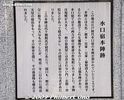
About Minakuchi's Honjin.Jul 04, 2009
|
|

Monument indicating that Emperor Meiji who stayed here in 1869. He was the last guest since the Honjin was then closed and dismantled. The Waki-Honjin was also nearby, but no signs.Jul 04, 2009
|
|

This is the rock which Tokugawa Ieyasu sat on when he visited the temple in May 1600. He sat on it while talking to the temple priest. Anyone can now sit on it. Called Tokugawa Ieyasu koshi-kake ishi. It was moved here in 1900. 腰掛石Jul 04, 2009
|
|

Further east is the Higashi-Mitsuke Gate. Jul 04, 2009
|
|

Jul 04, 2009
|
|

Jul 04, 2009
|
|

This Community Center also houses a hikiyama float.Jul 04, 2009
|
|

Old Tokaido Road.Jul 04, 2009
|
|

Minakuchi-juku documentsJul 04, 2009
|
|

Jul 04, 2009
|
|

Daitokuji Temple Hondo Hall. Ieyasu donated land to the temple as well as a tree. He even created the temple's crest and renamed the temple to Daitokuji.Jul 04, 2009
|
|

Inside Minakuchi Folk History MuseumJul 04, 2009
|
|

Minakuchi Christian Church designed by Vories and built in Nov. 1930.Jul 04, 2009
|
|

A detour on the old Tokaido road.Jul 04, 2009
|
|

About Higashi-Mitsuke Gate. After reaching this gate, you might as well backtrack back to the train station.Jul 04, 2009
|
|

Bridge to Minakuchi Castle.Jul 04, 2009
|
|

Jul 04, 2009
|
|

Jul 04, 2009
|
|

Minakuchi Shrine toriiJul 04, 2009
|
|

Old map of Minakuchi CastleJul 04, 2009
|
|

Minakuchi Stone at this corner is nicknamed Chikara Ishi (Stone of Strength) and was made famous by a woodblock print during the Edo Period. 力石Jul 04, 2009
|
|

Jul 04, 2009
|
|

This front gate at Shintokuji temple was moved from a lord's residence within Minakuchi Castle. 真徳寺Jul 04, 2009
|
|

Jul 04, 2009
|
|

Roof tile from Minakuchi CastleJul 04, 2009
|
|

Jul 04, 2009
|
|

After crossing the train tracks, you see this forked intersection. The road forks into three roads. The one in the middle is the old Tokaido Road. There is also a monument.Jul 04, 2009
|
|

This plaque shows a woodblock print by Hiroshige depicting Minakuchi-juku. (A clearer image of this print is shown below.)Jul 04, 2009
|
|

The monument takes the shape of a hikiyama float. It contains a clock inside. MAPJul 04, 2009
|
|

Minakuchi-juku was the fiftieth of the fifty-three stations of the Tokaido Road. The most prominent remnant is Minakuchi Castle. Short walk from Minakuchi Jonan Station and Minakuchi Ishibashi Station on the Omi Railway Line.Omi Railway Line at Minakuchi Ishibashi Station platform, the closest station to Minakuchi-juku.Jul 04, 2009
|
|

Inside Minakuchi Ishibashi Station, somewhat rundown.Jul 04, 2009
|
|
| 1139 files on 5 page(s) |
2 |  |
 |
|